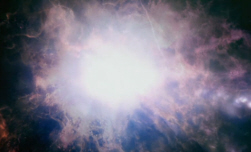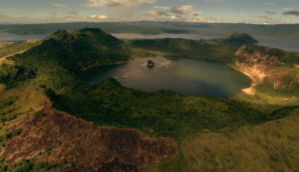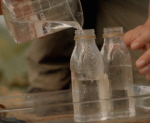Proton Gradient
Lake Taal
What is Life?

The Big Bang
The energy that's here now has always been here, and the story of the evolution of the universe is just the story of the transformation of that
energy from one form to another, from the origin of the first galaxies to the ignition of the first stars and the formation of the first planets.
Every single joule of energy in the universe today was present at the Big Bang, 13.7 billion years ago.
Potential energy held in primordial clouds of gas and dust was transformed into kinetic energy as they collapsed to form stars and planetary systems,
just like our own solar system.
In the Sun, heat from the collapse initiated fusion reactions at its core. Hydrogen became helium. Nuclear-binding energy was released, heating
the surface of the Sun, producing the light that began to bathe the young earth. And at some point in that story, around four billion years ago,
that transformation of energy led to the origin of life on Earth.
Around 350 km south of Sagada, this is Lake Taal. Despite its sleepy, languid appearance, this landscape has been violently transformed by energy.

Lake Taal

Volcanic Island
When I think of a volcano I usually think of a pointy, fiery mountain with a little crater in the top. probably a bit like that one. But actually
this entire lake is the flooded crater of a giant volcano. It began erupting only about 140,000 years ago, and in that time it's blown 120 billion
cubic metres of ash and rock into the Earth's atmosphere. This crater is 30 km across and in places 150 metres deep. That's a cube of rock 5 km
x 5 km x 5 km just blown away. It's a big volcano.
Taal Lake is testament to the immense power locked within the Earth at the time of its formation.
Since the lake was created, a series of further eruptions formed the islands in the centre. And at its heart is a place where you can glimpse
the turmoil of the inner Earth, where energy from the core still bubbles up to the surface… producing conditions similar to those that may have
provided the very first spark of life.
The water in this lake is different from drinking water in a very interesting way. See, if I test this bottle of water with this, which is
called universal indicator paper, then you see immediately that it goes green. And that means that it's completely neutral. It's called pH7
in the jargon. But then look at what happens when I test the water from the lake. Now the indicator paper stays orange. In fact, it might have
gone a bit more orange. So that means that this is acid, its about pH3.
At the most basic level, the energy trapped inside the Earth is melting rocks. And when you melt rock like this you produce gases. A lot of
carbon dioxide, and in the case of this volcano, a lot of sulphur dioxide. Now, sulphur dioxide dissolves in water and you get H2SO4, sulphuric acid.
Now, what I mean when I say that water is acidic? Well, water is H2O – hydrogen and oxygen bonded together. But actually when it's liquid it's
a bit more complicated than that. It's actually a sea of ions. So H-plus ions, that's just single protons. And OH-minus ions, that's oxygen and
hydrogen bonded together, all floating around. Now, when something is neutral, when the pH is seven, that means that the concentrations of those
ions are perfectly balanced. When you make water acidic, then you change the concentration of those ions and, to be specific, you increase the
concentration of the H-plus ions of the protons.

Lake Taal from the Air

Weak Acid
So, this process of acidification has stored the energy of the volcano as chemical potential energy. The volcano transforms heat from the inner
Earth into chemical energy and stores it as a reservoir of protons in the lake. And this is the same way energy is stored in a simple battery or
fuel cell. These bottles contain a weak acid and are connected by a semi-permeable membrane. Passing an electric current through them has a similar
effect to the volcano's energy bubbling up into the lake. It causes protons to build up in one of the bottles.
You can think of it, I suppose, like a waterfall, where the protons are up here waiting to flow down. All you have to do to release that
energy and do something useful with it is complete the circuit. Which I can do by just connecting a motor to it. There you go. Look at that.
That's the protons cascading down the waterfall and driving the motor around. It actually works!
Now, the fuel cell produces and exploits its proton gradient artificially. But there are places on earth where that gradient occurs completely
naturally. Here, for example. So we've got the proton reservoir over there, the acidic volcanic lake. If you look at that way, there is another
lake, and the reaction of the water with the rocks on the shore make that lake slightly alkaline, which is to say that there is a deficit of
protons down there. So here's the waterfall, a reservoir of protons up there, a deficit down there. If you could just connect them, then you'd
have a naturally occurring geological fuel cell. And it's thought that the first life on our planet may have exploited the energy released in
those natural proton waterfalls.




